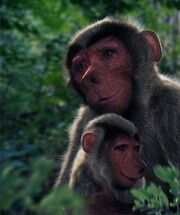
This primate, was small and lemur-like. Several such primates have been found from the layers of the Eocene forests. Godinotia was an inhabitant of the dark canopies of the Early Eocene forests. Having large eye sockets, thus large eyes in life, the prosimian was most likely a nocturnal animal.
Godinotia was a small lemur-like primate that lived in the Early Eocene Epoch of Germany. It is known from the Messel Shales, as are many other unique animals. The time range of Godinotia is only known to be 49 Million Years Ago. Godinotia was a nocturnal primate, similar looking to the monkeys, but not a true monkey as we know them today. It belonged to the older Adapids - which in turn actually belong to the Prosimians, meaning that Godinotia was more closely related to the Marmosets, Tarsiers and Bush Babies that are still with us today - which were the forerunners of true monkeys in their niche, which appeared around 36 Million Years Ago. They were probably solitary animals, as complex social behaviours, as well as brain sizes, were still very far from being well developed, and they were rather primitive in comparison with later primates. They were small, omnivorous primates, which ate both insects and fruit; which is evidenced by the shape of their teeth. Their limb bones were ideal for leaping from tree trunk to tree trunk, and for running along branches. The Godinotia measured around 30 cm long, not including the tail which probably measured almost the same, meaning the animal was no bigger than a domestic cat. Godinotia, is named after Marc Godinot, the scientific researcher who discovered it.
Godinotia is notable for being one of the oldest known primates, and also is apparently the only extinct primate ever for which a baculum - the penis bone - has been found (though others would have had this) The penis bone helps in sexual intercourse in mammals, and most mammals possess some form of baculum. Strangely, of all the primates, Humans are the only ones to lack a baculum. This means human males have to rely solely on blood pressure in a hydraulic fashion to achieve and maintain an erection. This is at some considerable cost to energy and has noted to become difficult as men age and become weaker. Without the baculum, this is a reason why erectile dysfunction occurs in many older males of our species, as any number of factors can change the blood pressure and health of the individual for the worst. Maintaining erections for humans is much more difficult with the 'stabilising rod' of the baculum. The Godinotia were, like most mammals still are today, solitary and as such would not form relationships whereby frequent sex with a single partner was assured. Therefore, sexual activity was only available to the male Godinotia when they randomly met females whilst foraging at night. Henceforth, the male had to be ready at all times to immediately engage in sexual intercourse whenever he sighted a female. Godinoia were probably very sexually active and rather rampant. Their baculum allowed them to have sex for a very long time, without fear of losing their erection due to fatigue. This ensured that it was his sperm that impregnated the female, as the act would take so much time that fertilisation would have occured if the female ovulating. This compensated for their solitary nature, which would perhaps otherwise leave them in danger of not passing on their genes efficiently, and it could be said that without the baculum, they could fail to ensure impregnation. This behaviour is evidenced with their relatives that survive to this day - the Bush Babies, Marmosets and Tarsiers. These are solitary, and behave in exactly the way described in suggestion for Godinotia. Godinotia were probably most vulnerable when drinking from lakes and rivers - as they could have easily fallen prey when ambushed, to large crocodiles and the bizarre 3 metre long ancient whale, Ambulocetus.